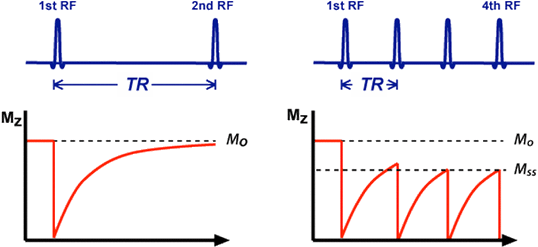The concept of magnetic saturation was introduced in an earlier Q&A. As a brief review, before any RF-pulses are applied, the longitudinal net magnetization (Mz) it at maximum value (Mo) and the transverse components of magnetization (Mxy) are zero. Once RF-excitation begins, the longitudinal magnetization begins to fall until it reaches a steady state value Mss, which is less than Mo. In some rapid GRE sequences a coherent transverse magnetization develops and reaches a nonzero steady state as well.

Partial saturation and development of steady-state magnetization (Mo)
[left] TR >> T1 so there is complete recovery of Mz back to Mo before the 2nd RF-pulse.
[right] TR is shorter and Mz does not fully recover before next RF-pulse is applied. After a few pulses a new steady-state longitudinal magnetization (Mss) is reached, with Mss < Mo.
[left] TR >> T1 so there is complete recovery of Mz back to Mo before the 2nd RF-pulse.
[right] TR is shorter and Mz does not fully recover before next RF-pulse is applied. After a few pulses a new steady-state longitudinal magnetization (Mss) is reached, with Mss < Mo.
To allow these steady-state magnetizations to become established, the scanner plays out several cycles of the sequence without recording a signal. Only once the system is near equilibrium does data collection begin. These are called dummy cycles, disabled, or discarded acquisitions (DDA). The precise number of dummy cycles depends on the TR and the sequence chosen. The number may vary from just a handful to more than 50 (for steady-state GRE sequences with short TR's).
Advanced Discussion (show/hide)»
No supplementary material yet. Check back soon!
Related Questions
What is the scanner doing during the automatic pre-scan period?
What is the scanner doing during the automatic pre-scan period?
